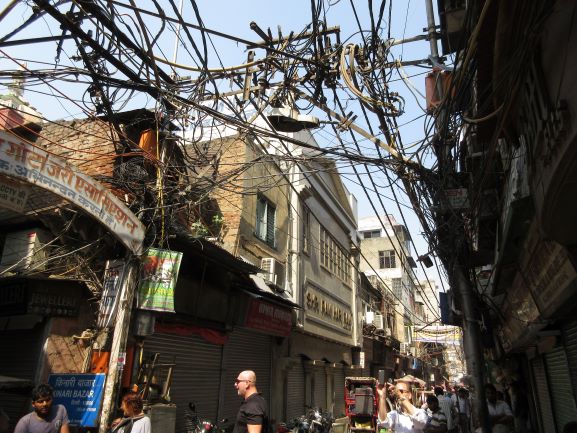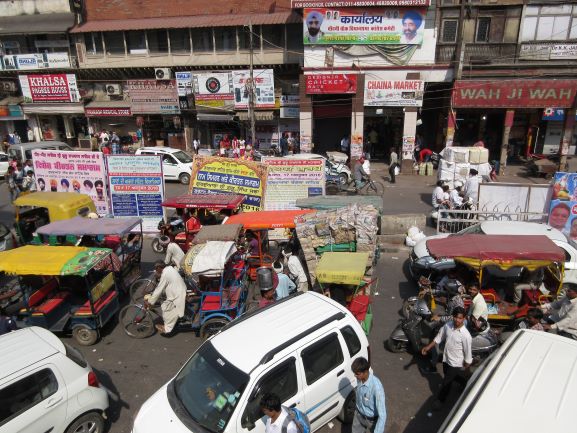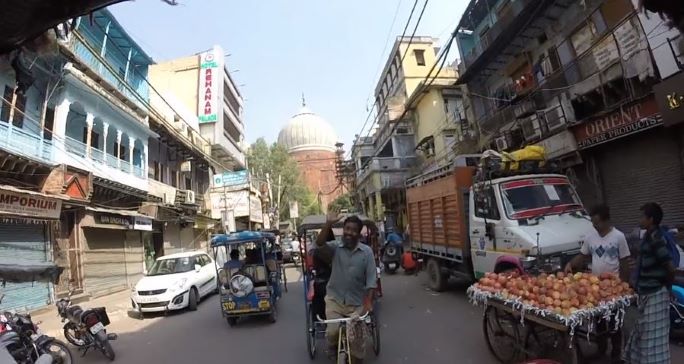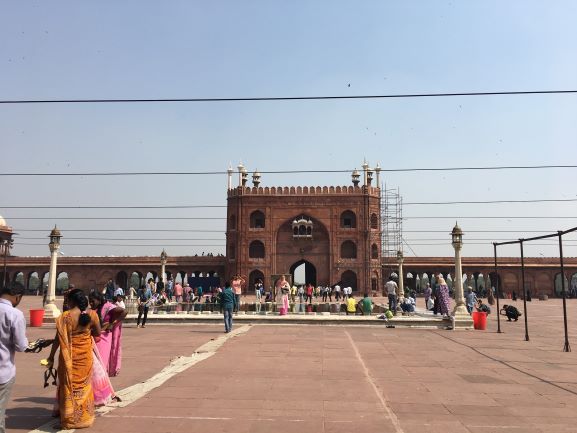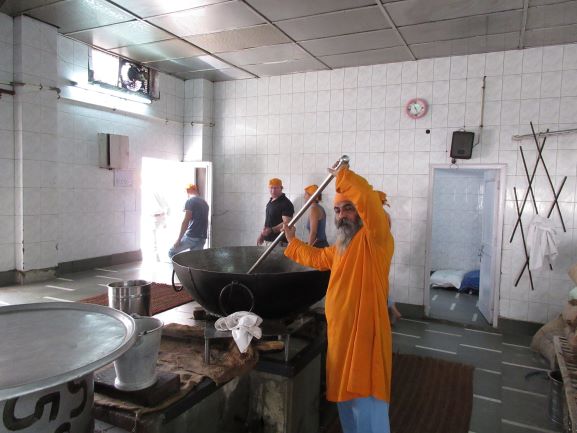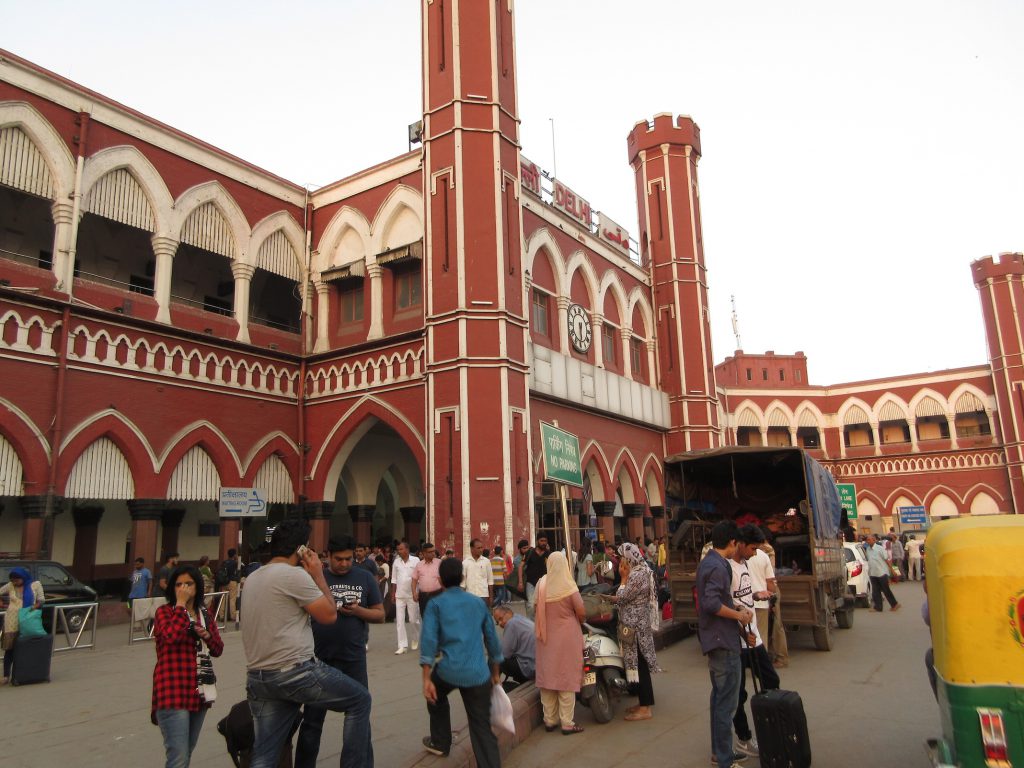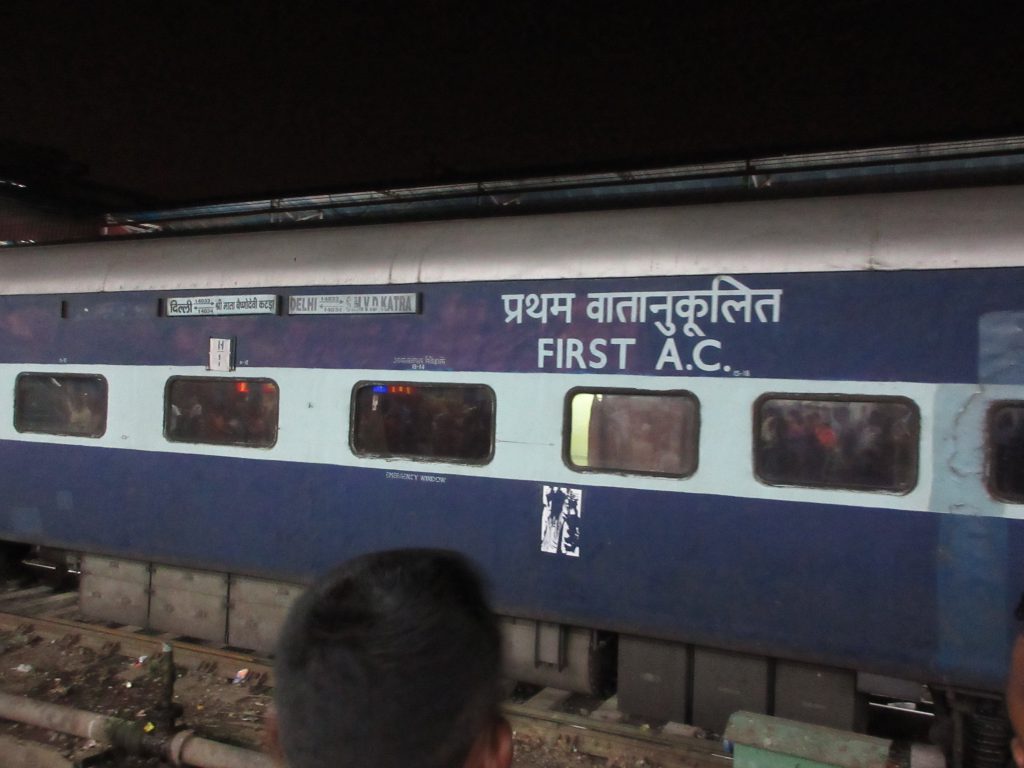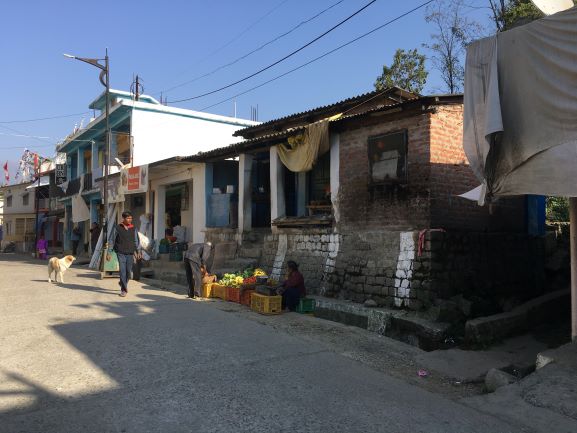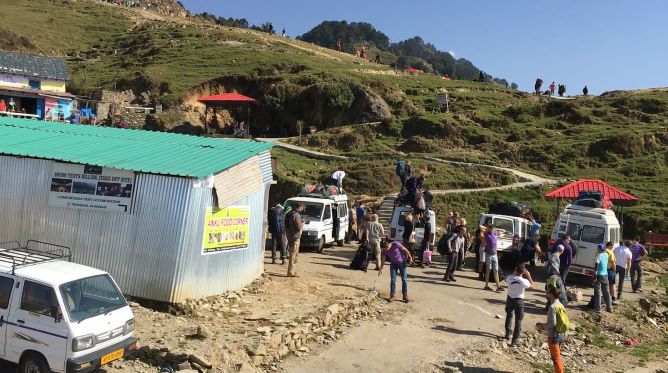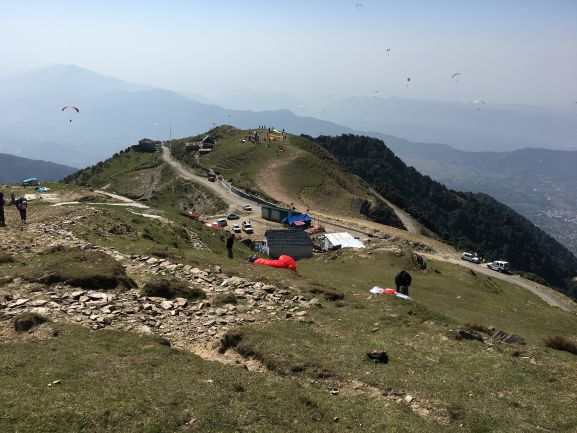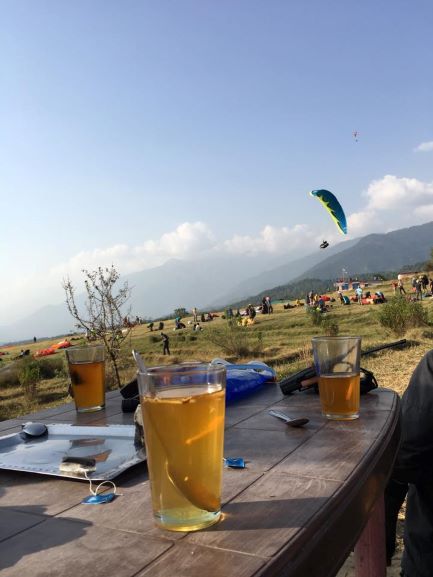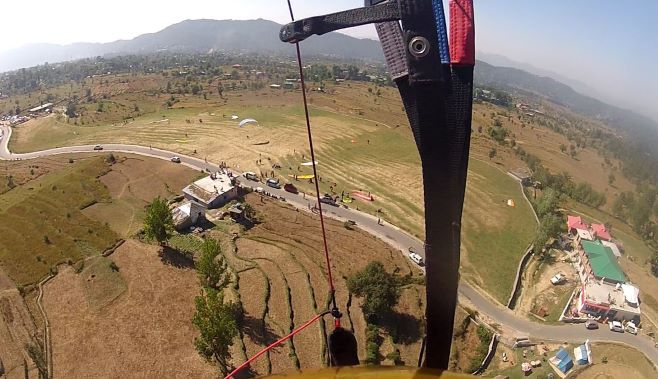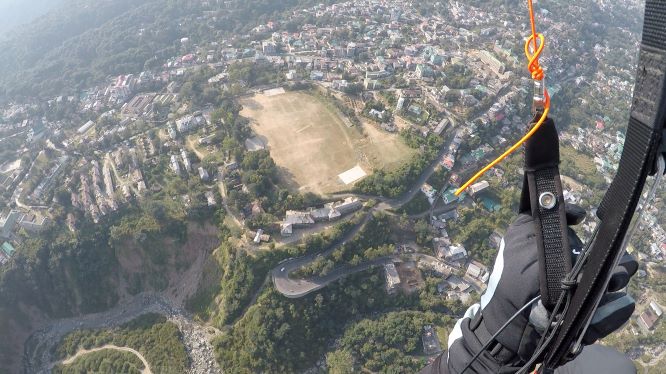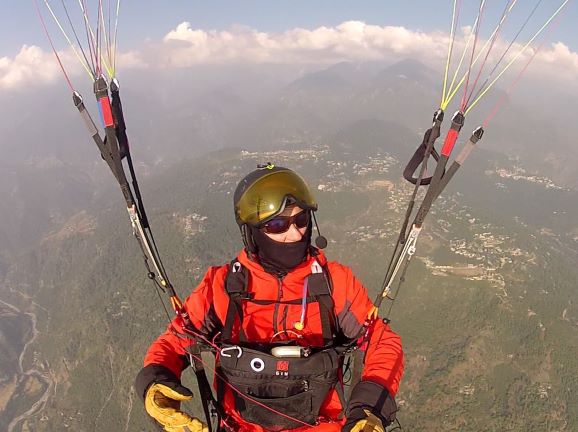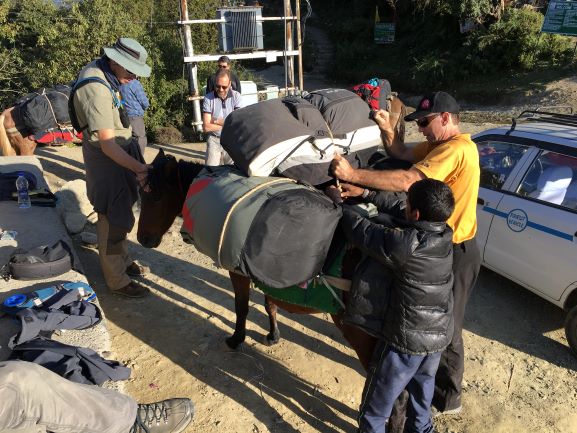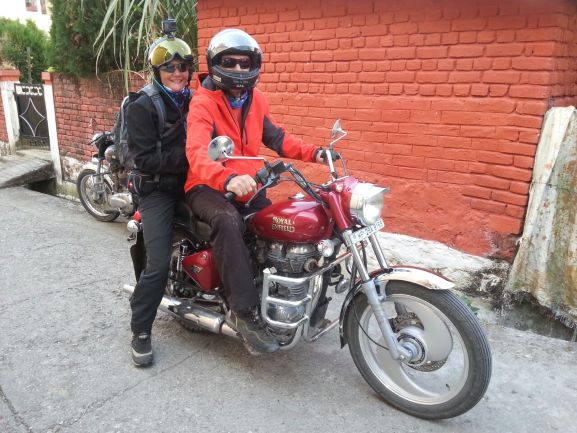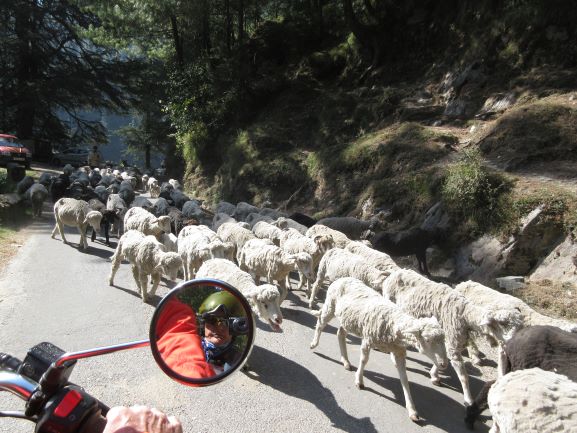In October 2016 we went with a group to Bir Biling in North India. Together with Marga, one of the pilots on this trip, I wrote an article for Lift Magazine (Dutch). Below you also find some videos about the trip to get a feel of this country and the amazing flying possibilities. And of a near miss with a vulture!

During a trip to India at the end of October 2016 we, Daphne and Marga, got to know each other (together with our partners Koos and Marc). Because it was a very special trip, both culturally and technically, we came up with a story for the Lift Magazine.
Because our interest in this trip has been created in a completely different way, we will be speaking in turn.
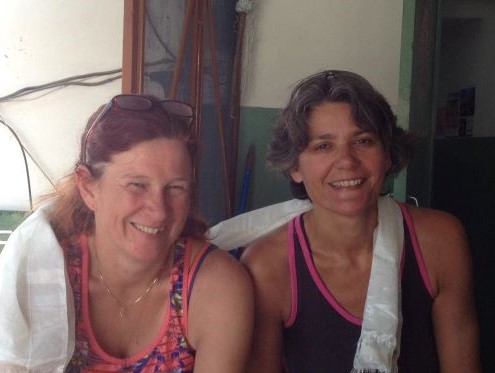
Daphne: The leaflet had been hanging on the bulletin board in the kitchen for more than three years, even a year before we start to fly paragliders; flying in the Himalayas. It was one of the reasons for me to do a course of paragliding next to hang gliding. With our hanggliders we would probably never (with the same ease) have come to this place and this autumn we finally leave for India with Paragliding Holland.
Marga: At the end of 2015, on Xcontest, I saw beautiful long flights of a few Dutch pilots on the edge of the Himalayas in India. A little bit of research led me to Paragliding Holland who organizes trips there. It seemed amazing to me, combining culture, the Himalayas and long flights (who knows at last 100 km!).
Incredible India.
You have the choice to find it a horrible place and there are plenty of reasons for that. The terrible environmental pollution and suffocating smog that hangs over Delhi. Poverty, misery and beggars. The total madness on mostly bad roads where deafening honking cars, motorbikes, rickshaws, tuk-tuks, trucks and buses compete to get from A to B as quickly as possible. While in addition to pedestrians they also have to avoid horses, dogs, holy cows, herds of goats and sheep and crossing monkeys. But I choose to amaze and admire everything; here in India it really is all different. It is also the land of many religions that live (apparently) peacefully next to each other and hospitable people who receive tourists with open arms. The delicious smells and flavors of Tibetan and Indian cuisine that spoil us with 3 delicious meals (for less than € 10, -) per day. Not to mention the colors of the varied landscape, clothing, houses and richly decorated monasteries.
The trip’s highlight is flying in North-West India at the Bir Biling fly-spot known from the 2015 World Cup. But our tour guide / instructor (although you are expected to be able to fly independently) Vincent has – because he lived and worked in India – endless interesting stories to tell about the culture and the area. That makes the trip very special from day one. After getting to know the group, we start in Delhi with a walk in Old Delhi. We walk through small streets where there is hardly any sunlight, we visit a Sikh Temple Sikh Gurudwara, where we receive a guided tour during a festive prayer service and we visit a gigantic Mosque that can hold upto 25,000 people. Of course we travel with the modern metro and we take a rickshaw to come back again.
In the evening we depart from the train station with the night train to the north; an experience in itself. We have to be ready with all our gear to get on the train as quickly as possible and divide ourselves over reserved coupés with 4, 6 or 9 beds. The train makes many stops along the way and we also have to be ready in time to leave the train the next morning as it only stops a few minutes at the station Pathankot.
After this somewhat restless night we take a taxi to Dharamsala where we need to get a P.A.P. (Protected Area Permit) with which we can stay in the Tibetan colony. Meet bureaucratic India: after we have handed in a large stack forms, passport photos and copies of all kinds of documents, the big wait for the magistrate’s signature begins. In order to spend the long wait well, we visit Mcleod Ganj, a village located higher up on the mountain where the residence of the Dalai Lama is located and which very popular with tourists. Here are many shops with buddhas of all shapes and sizes. We walk along prayer rolls and of course we visit the monastery. Just when our taxi descends again, we are overtaken by a blinded car with an extensive police escort; could it be the Dalai Lama? In any case, our driver succeeds in staying behind the procession, allowing us to drive the narrow mountain road three times faster than we have come up. When all papers have been signed we can continue to Chaughan; a 2 hour drive.
We marvel at the landscape and villages with shops and the accompanying crowds, rice fields, farmlands and temples. Finally we arrive at our final destination where it is much quieter, cleaner and more beautiful and where the Himalayas rises up with impressive mountain peaks. The Tibetans are doing well here. A large part of the group stays with Tibetan families at home; in our case two very spacious rooms with private bathroom and kitchen unit (without kitchen utensils, though) and shared entrance. Unfortunately Tibetans prefer very hard mattresses and my spoiled western back cannot get used to it. As joint neighbors we have invested in a hot water kettle. During our tea sessions at night we evaluate the daily experiences and get to know each other better.
Flying in Bir
Our group consists of two guides, Vincent and Anton, and 13 enthusiastic pilots with diverse flying experience. A nice and friendly group with whom it’s good flying and having fun. Everyone wants to make beautiful flights and all in all we fly every day with another set of pilots which makes it both easier and more fun. Flying together is always a challenge, if only because not everyone is accustomed to passing on position and height (‘is there someone in the neighborhood?’ Is a difficult question to answer …).
The Bir Biling launch site (2400 m) is located on the first foothills of the Himalayas. To the south is the plateau, which is unfortunately poorly visible due to the many fields that are on fire to eliminate the remains of the harvest (which by the way is prohibited by law…). To the north one mountain chain follows one after the other and the mountains quickly rise in height against an often beautiful blue sky. Flying north means that you can get higher because the cloud base there is 1,000-2,000 meters higher but also that your landing options are rapidly decreasing. Most of us do not go there and stay at the front where you reach up to 3,500 meters on a good day; you then hop, as it were, from mountain top to mountain top over the entire distance.
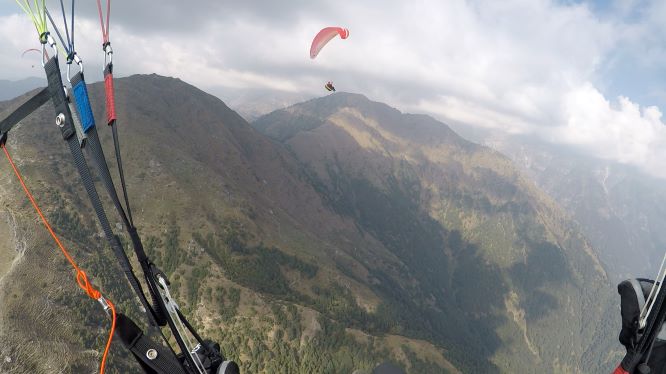
To the west, Dharamsala is about 43 km, which is usually chosen as a target in the morning because you have a tailwind. If you manage to get there, then in the afternoon you generally also have wind on the way back or at least south wind so you can fly soaring along the slopes. To the east, Camp 360 is about 15 km from the start and those who still have energy left they go for this turning point as well. If you have flown that entire route then you have over 120 km on the counter!
To get to the start we go up with taxis that pass each other on the narrow road with a lot of honking. Then you have to walk a bit further to join the many waiting pilots of different nationalities. You can launch in different directions and choose from both a steep and a flat start from as early as 9.30. The house thermals are pretty homogeneous, although one day is easier than the other. Although it is very busy, the launch is relaxed and there is always someone who offers a helping hand and also in the air, most of the pilots stick to the priority rules.
The flying experience
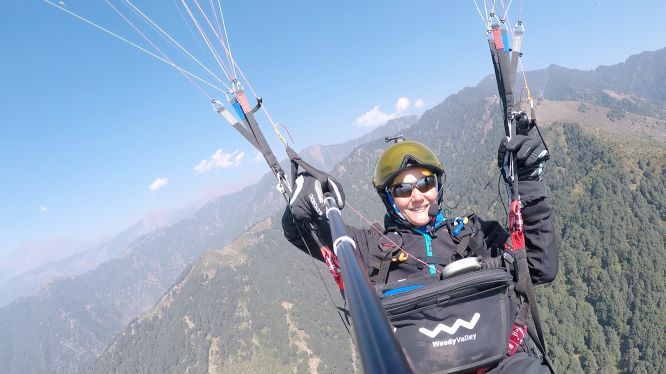
Daphne: The first day I make a small trip of 32 km and immediately break all my personal records of height, duration and distance. It takes some getting used to in the air and the area and I immediately have to make an outside landing because I do not dare to go over the long forest. That did worry my in advance, I must admit. Where houses are, there are poorly visible electricity cables and so I keep a large margin to choose the rice field where I am going to land. Wide fields (4-5 meters!) Means that the valley is flat; narrow fields that slopes are steeper. You have to take all this into account and in addition you have to land in the length and not in the width of the field, whatever the wind direction is! But in the end it’s not too bad and even before I can pack my stuff there is already a taxi driver in front of me: “Taxi Madam?” He asks friendly after which he charges me too much for the ride … Something that of course won’t happen to me a second time.
The next day I am ready to launch when one of our group makes an error and unfortunately lies a few meters below the launch with a broken ankle. The three of us make sure that he gets in a taxi and Vincent has made a top landing to accompany him further down; unfortunately it is the end of his holiday for the unfortunate pilot. I do not fly very far myself and have set myself the goal of landing on the official landing field in Chaughan. Pay attention at landing, because it is very busy and pilots come from all sides while at the same time you also have to avoid the students practicing in the field. In spite of the hectic situation I have not been able to observe any, really crazy, landing during all those days.
Landing in the target field means that you can join the local landing drink: ginger honey lime tea. Alcohol is only sold in special shops and is relatively expensive.
The conditions are very favorable so we can fly nice distances every day under a usually blue sky with some clouds above the higher mountains. Some of us fly up and down to Dharamsala every day (80 km). Although no instruction is given or tasks are set out, we do have a lot of conversations about our flights over dinner, and how to improve our flying. I learn more about flying with speed and dare to fly closer and closer to the mountains, so that I can do more soaring instead of thermalling my way to Dharamsala and back.
The thermals are indicated by many pilots and by beautiful birds such as many vultures, milvus milvus (rode wouw) and eagles. But please: do pay attention; they are more concerned with what happens on the ground than anything that flutters around! So I have a near miss with a vulture at less than 2 meters. After this experience I call at them as a precaution, so that they notice me earlier and keep their distance. It is also advisable to keep the same direction of rotation, although they exchange more easily than we do. But it remains great to fly in thermals with them.
Marga: Everything in the Himalayas is bigger than in the Alps: the tree line is higher (almost 3000 m), the crossings are longer, the clouds are gigantic yet harmless. For the first time, I soared up in front of a cloud: great experience to be able to play with the big clouds there. The thermals are very large, but in a thermal you have different sub-thermals with different rise values. It took me a moment to realize that thermals that seemed to coexist were actually one big thermal. And of course the birds. The vultures in India really react differently than the vultures in Europe. It seems as if they have taken over the kindness and mutual tolerance of the Indian people.
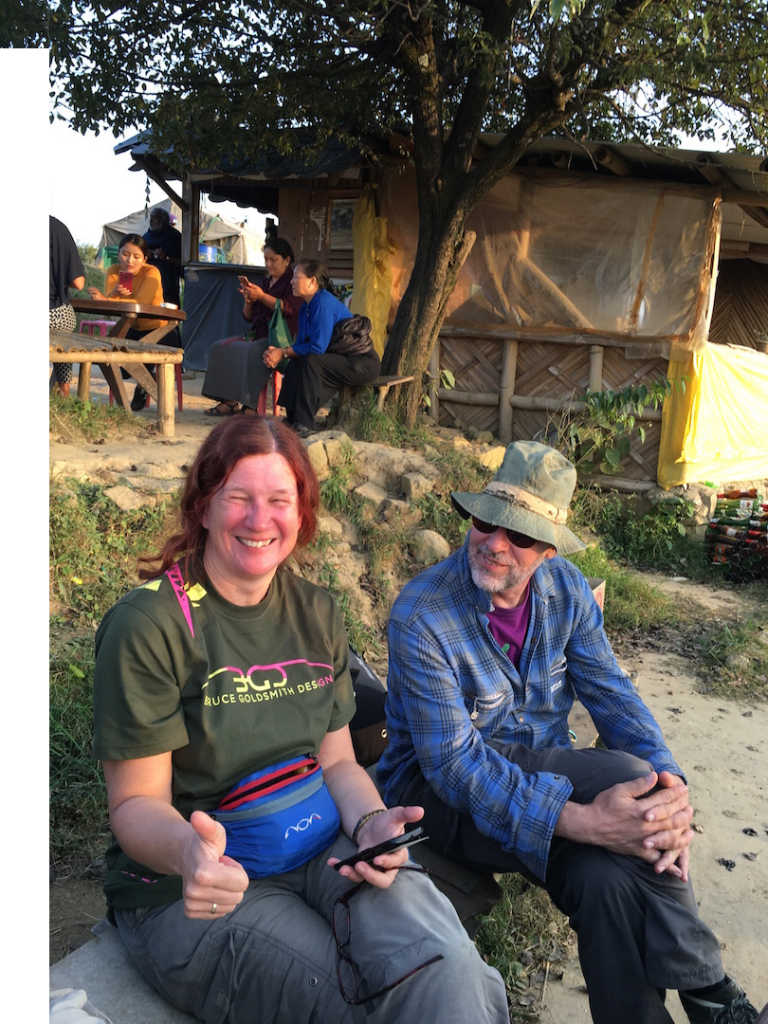
The fourth day is THE day: the circumstances are still optimal, I launch earlier than I would normally do and I am going for it! With the dreamed result, +100 km is in the pocket! Hubby is also happy again, I can now act normally again according to him.
Daphne: Halfway through the second week we decide to fly to Dharamsala with a small group of 7 pilots. It takes me about 3 hours and I stick around above Mcleod Ganj and Triund before I, like Vincent, Marga, Marc and Koos land in the football stadium. Later, Pieter and Tabiso join us; they made landed halfway. We spend the night in Dharamkot, a little village higher on the mountain and leave the next morning at sunrise on foot to Triund; about 900 vertical meters climb to 2,850 meters. The paragliders are transported on the backs of 3 horses, led by a 15-year-old boy, up the narrow path. It is a beautiful walk with great views over the valley and the high mountains. There are many tents on top where Indian tourists stayed the night to watch the sunset and sunrise. Here we meet Rinse and Eloy again who flew with us and made a top landing and bivouac (brrr …). After we have recovered from the walk we launch and fly back to Chaughan. Some reach more than 4,000 meters by flying along the high, rugged mountain ridge. A beautiful sight and I realized my dream flight!
Because there is so much more to do and see in this area, we rent a motorbike one day to drive across the pass to the Bharot Valley. It seems as if time has stood still by the way people live and work there. We also see that it is indeed not very easy to land here, if not impossible. Landing here means very long return journey because the bus only departs from the valley in the morning!
Flying in Bir Biling also has disadvantages; it is such incredibly good weather that everyday we fly 3,5 to 5 hours! Our group of 11 pilots together we fly 300 hours, 103 flights and a total of 4852 km!
Daphne: I could get used to a long stay in this beautiful area with it’s beautiful nature, friendly people and the relaxed pace of life. We will definitely come back and for those who are not averse to a beautiful flight adventure, it is highly recommended! (Not knowing that we would soon after decide to become Flying Nomads!).
Marga: It was a great holiday, with impressions and experiences that I have never had before, both on the ground and in the air. But I still am not sure whether I have been in heaven or hell. One thing is certain, walking around and flying in such a different culture is a great experience that I definitely want to experience more often.

